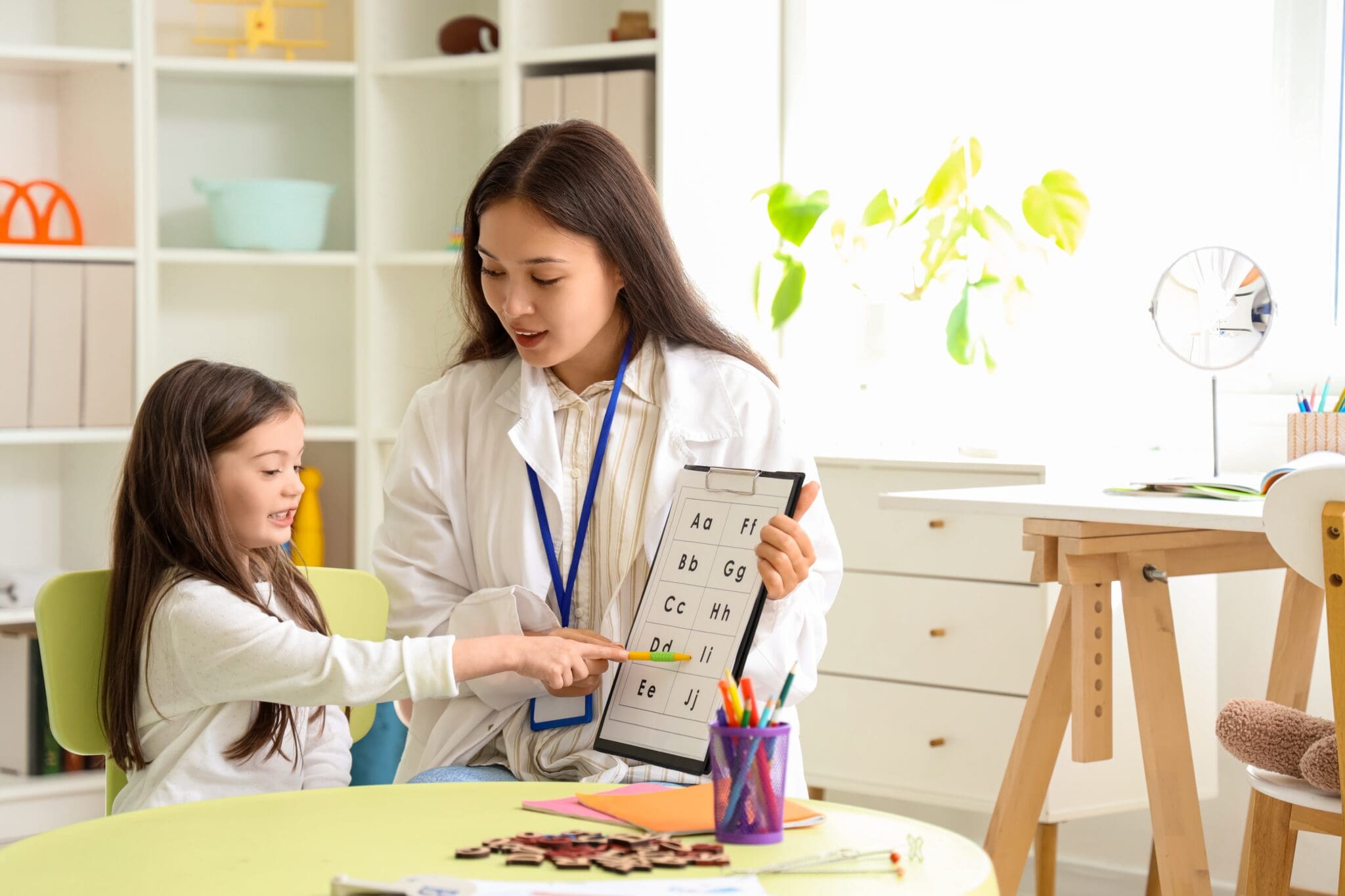In this article
UK government statistics estimate that around 6.3 million people in the UK have dyslexia, which is about 10% of the population, with approximately 4% of these people experiencing severe dyslexia. Of these, between 800,000 and 1.3 million young people in education in the UK have dyslexia, although the Teaching Times reports that 80% of people with dyslexia are undiagnosed when they leave school.
There may be many reasons why so many people, particularly children go undiagnosed for dyslexia, such as limited resources for diagnosis and intervention, misconceptions about what dyslexia looks like, such as the idea that it is only about difficulty with reading words, or lack of awareness among parents and/or teachers about how to identify the signs of dyslexia, especially its more subtle indications. In this article, we look at the sign of dyslexia at different stages of a child’s development and highlight some of the affects that having dyslexia can have on children, their education, their everyday life, and their future working life.
What is dyslexia?
Many people when they hear the term dyslexia have the misnomer that a dyslexic person just sees words, letters or numbers backwards, or that it is solely a visual issue, a kind of word blindness. True, the phrase word blindness was once used to describe what is now known as dyslexia, but it is a much more complex condition which can affect individuals very differently in terms of how it manifests and its severity.
The word dyslexia comes from Greek, dys meaning disturbed functioning, and lexia meaning word, and dyslexia has been defined as a set of processing difficulties in phonological awareness, verbal memory and verbal processing speed that affect the acquisition of reading, writing and spelling. The condition is a form of neurodivergence which can range from mild to severe, and can impact not only reading, writing and spelling, but can also impact other areas of education and day to day life.
Neurodivergence means having a brain that forms or works differently, and it is an umbrella term for conditions that include dyslexia, dyspraxia, autism, dyscalculia, ADHD, and Tourette’s. Dyslexia frequently co-occurs with one or more other developmental difficulties, including developmental language disorder, dyscalculia, ADHD, and developmental coordination disorder.
Because dyslexia is a neurological condition that affects how the brain processes written language, it is important to recognise how the brain functions in regard to language to better understand the condition.
The brain consists of two hemispheres. Each hemisphere can be divided into four lobes or regions: frontal, parietal, temporal, and occipital. The left side of the brain is associated with language processing, speech, and reading. Each lobe has a unique role in reading words and they interact with each other to link printed words with letter sounds and meaning as follows:
- Parietal-temporal lobe, where a written word is segmented into its sounds (word analysis, sounding out words).
- Occipital-temporal lobe, where the brain stores the appearance and meaning of words (letter-word recognition, automaticity, and language comprehension).
- Frontal lobe, where speech is produced (processing speech sounds as we listen and speak).
Dyslexia is believed to be caused by differences in brain development and / or function, specifically in areas that are responsible for language processing and reading. These areas are located in the left hemisphere of the brain and are:
- Broca’s area – this is located in the frontal lobe, and it is responsible for the production of speech, including articulation and grammar.
- Wernicke’s area – this is located in the temporal lobe, and is primarily involved in understanding both spoken and written language. It helps to process the meaning of words and sentences.
- Angular Gyrus – this is located in the parietal lobe, and it plays a crucial role in reading and language comprehension. It helps to convert written words into an inner voice, assisting in processing written language.
- Arcuate Fasciculus – this is a neural pathway that connects the frontal and temporal lobes, primarily connecting Broca’s area (speech production) with Wernicke’s area (speech comprehension).
- Occipital-temporal region – this refers to the area of the brain where the occipital and temporal lobes connect and interact and is crucial for visual processing and visual cognition.
Some research suggests that dyslexics may rely more on the right hemisphere of the brain for reading, showing less activity in the left hemisphere areas typically used by fluent readers. However, whilst the brain’s left hemisphere may be less active in people with dyslexia, the right hemisphere is not necessarily the dominant one. Instead, dyslexic brains may rely more heavily on the right hemisphere for certain aspects of processing, such as visual-spatial skills and pattern recognition, meaning that the right hemisphere is not the primary driver of cognitive processes in dyslexia. Although dyslexics may struggle with language-based tasks such as reading and spelling, they can excel in areas that leverage their right-brain strengths such as creativity, problem-solving, and intuition.
People with dyslexia process information in their brains differently from the majority of people. Although these differences can occur at any point in a person’s life, dyslexia is primarily a condition that people are born with, this is known as developmental dyslexia, and it tends to run in families. However, for many children the signs of dyslexia may not always be recognised by parents and / or educators, so the condition may go unidentified and undiagnosed for some time, even as late as adulthood.
Dyslexia can develop in adulthood, but this is known as acquired dyslexia, and is usually caused by a brain injury, stroke, or other illness that damages the brain and disrupts processes such as reading.
Dyslexia is complex, life-long condition, and the number, type and severity of the characteristics can vary from one dyslexic child to another. There is no cure for dyslexia and individuals with this condition must learn mitigation and coping strategies, and can use assistive technology to support them. However, dyslexia has no relationship to intelligence. Individuals with dyslexia are neither more nor less intelligent than the general population. What is important is that the earlier dyslexia is diagnosed, the better placed that they are to get the appropriate educational support to improve their chances of educational and workplace success. Let’s look at some of the signs at different stages of childhood that may indicate that a child may have dyslexia.

Signs of dyslexia in early years
Dyslexia often shows its first signs during a child’s early years. These signs can seem subtle and may go unnoticed or be mistaken for typical development struggles. As dyslexia can be genetic, if there is a family history of dyslexia or reading difficulties, particularly in close family such as parents or siblings, this may be an early indicator of dyslexia for a young child who is having difficulties with words and language. Other signs might include:
- Slow speech development, or developing later than other children of the same age. First words might be difficult to understand
- Using jumbled phrases and muddled words such as flutterby for butterfly, beddy tare for teddy bear or persgetti for spaghetti
- Having word finding difficulties or difficulties naming familiar objects, for example using non-specific words such as thingy or stuff, or making up similar-sounding words
- Requires more thinking time to remember the correct word
- Having difficulty learning the alphabet and remembering the sequence or the names of the letters, or trouble singing the letters of the alphabet
- Having difficulty learning numbers, days of the week, colours and shapes
- Getting the spelling wrong or missing out letters when writing their own name, or writing mummy or daddy
- Trouble memorising their own address, phone number etc.
- Difficulties learning nursery rhymes or song lyrics that rhyme, often can’t create words that rhyme
- Difficulty remembering and following simple instructions or directions with multiple steps
- Constant confusion of left and right
- Avoids any attempts to learn to read or shows frustration with simple texts
These early signs don’t confirm a diagnosis for dyslexia, but they can indicate that further observations and an early assessment could be beneficial. Preschool assessments can focus on phonological awareness and word retrieval, but full evaluations that can lead to a diagnosis do not usually take place until the child has formally started to learn to read, typically from their second year at primary school.
Being able to alert teachers of potential signs of dyslexia when a child starts their formal education at primary school, will not only help the child, it will also enable the primary school to monitor the child as they formally learn to read, and to be vigilant to any difficulties that the child may be having.

Signs of dyslexia in primary school
It is very important to identify dyslexia as early as possible and whist some indications may have been observed in a pre-school child, it often becomes far more evident that a child is having difficulties with reading, writing and spelling once they start primary school. Signs that a primary school aged child may be dyslexic that parents/care givers and teachers should look out for may include:
- Having significant difficulty learning to read, including trouble sounding out new words and counting the number of syllables in words
- Taking much longer to learn the connection between letters and sounds, often confusing letters that look similar such as b, d, p, and q, or sound similar such as f and v, b and p, or d and t
- Avoiding reading out loud in class or getting frustrated or upset when reading
- Lacking fluency in reading, continuing to read slowly in comparison to their peers
- Having difficulty blending sounds to make a word for example saying t-r-a-ck instead of track
- Tries to guess the word rather than reading it
- Skips over words or even sentences when reading
- Substituting words when reading aloud, such as saying house when it is written home
- Confusing or skipping small words such as for and of when reading out loud
- Immediately forgetting what has just been read
- Does not know the order of the alphabet
- Continuing to reverse letters and numbers when reading and writing beyond the age of 6 years
- Has trouble correctly spelling even familiar words; often spelling them phonetically such as WENZ-day for Wednesday or TAY-bul for table
- Misspelling the same word in different ways or mixing up the sequence of letters
- Forgetting how to spell words that they have already been learned
- Using the wrong vowel sound in spelling and/or adding extra letters
- Having trouble remembering how words are spelt and applying spelling rules in writing
- Slow, poorly formed handwriting, signs of crossings out or erasing, poor page layout
- Being unable to organise all their ideas in written work
- Copying text from the board or from a book is slow and inaccurate
- Avoiding writing or getting frustrated when writing
- Difficulty telling time on a clock with hands
- Has trouble understanding signs
- Difficulties with learning the rules to games or sports
Whilst many primary school aged children may have difficulties and will develop their learning abilities at different paces, in children who may be dyslexic the difficulties will often be more severe and persistent. A child with dyslexia is likely to have a mix of these difficulties highlighted above, but may not necessarily display them all.
Identifying the signs for dyslexia early in a child’s school career can alert teachers and/or parents of the need for a formal assessment to better understand the issues that are restricting the child’s progress, and can lead to a diagnosis that can help to get them the support that they need.
Signs of dyslexia in secondary school
Some children although they have struggled with their reading, writing and spelling for years, have been able to hide their problems through sheer determination and hard work. But these problems may become more challenging for them as they go through their secondary education and are required to work at a higher academic level. Others may have simply slipped through the system, their problems going unnoticed, or been put down to behavioural issues. Whatever the reason, there are many children who are in secondary education and have not had a dyslexia assessment or diagnosis even though they may be displaying signs for the condition, these include many of the signs described above and also:
- Repeatedly needing to read and reread material in order to understand it
- Preferring to have assignments or instructions read to them rather than having to read it themselves
- Displaying anxiety from reading or writing
- Difficulties spelling
- Confusing similarly-spelt or sounding words such as their and there, break and brake, course and coarse
- Having a limited vocabulary
- Often searching for words, or using substitutes such as gate instead of fence
- Showing no signs of improvement in their handwriting as they get older
- Not noticing errors when proofreading what they have written
- Difficulty with simultaneously listening and writing / typing
- Having trouble understanding or remembering instructions or directions
- Difficulties with learning a foreign language
- Not carrying out or missing deadlines for assignments and / homework because they did not fully understand the requirements
- Discrepancy between the child’s grades and those of their peer group
- Struggling to remember common abbreviations, including ones used in text, messaging or on social media
- Difficulties understanding the more complex language of maths
- Difficulty extracting information from diagrams, charts, graphs etc.
- Handwriting becomes illegible when under pressure such as in exams
- Difficulties with exam revision activities such as reading, memory, concentration, planning, organisation and time management
Children of secondary school age may have a better understanding themselves of neurodivergence, and neurodivergent conditions such as dyslexia, and may alert teachers and/or parents/care givers of any difficulties that they may be experiencing. Many secondary schools cover the topic in Relationships, Sex and Health Education (RSHE) classes, and media and social media regularly highlight the struggles that various celebrities have with neurodivergence, so children at this age can be well informed. However, there may also be many secondary school age children who are unaware of why they are struggling with reading, writing and spelling, and who need to rely on teachers and/or parents to recognise signs that they may be dyslexic.
Whilst assessments and diagnosis for neurodivergent conditions such as dyslexia benefit from early intervention, an assessment can be arranged at any age, even well into adulthood, so it is never too late to be assessed, diagnosed and to get the support and any reasonable adjustments necessary to remove barriers, facilitate participation and access opportunities on an equal basis with others.
Dyslexia is a condition that is a recognised disability under the Equality Act 2010 in the UK, meaning that if it has a substantial and long-term adverse effect on a person’s ability to carry out normal day-to-day activities, they are entitled to request that reasonable adjustments are made in schools, colleges and workplaces so that they can fully participate in their education and work.
How does dyslexia present in children?
As with the signs that a child with dyslexia may display, how the condition presents in children can also vary from child to child depending upon the severity and the specific aspects of their dyslexia. Let’s look at some of these aspects in more detail, however it is important to note that the aspects of dyslexia may present very differently in each dyslexic child, and children can have completely different experiences of the condition from each other.
One of the main problems in dyslexia is trouble recognising phonemes; these are the basic sounds of speech. Each sound you hear in a word is a phoneme, such as P-A-T in the word pat; it is the smallest unit of sound that makes up a whole word. With dyslexia, difficulty with phonetic decoding is a hallmark characteristic of dyslexia, decoding is the process of reading words by sounding them out, using knowledge of the relationship between individual sounds (phonemes) and letters (graphemes) in a word. It involves identifying the sounds in a word and blending them together to form the whole word.
Decoding skills contribute to the development of reading fluency, as it allows readers to quickly and accurately recognise words. In dyslexic children this can present as struggles with the sounds of language and their relationship to written letters when reading. Words which don’t follow standard phonetic patterns such as though, of, said or was, can be particularly difficult for dyslexic learners to decode, and children may spell a word the way that it sounds, for example, they may spell though as tho, of as ov, said as sed, or was as woz. For a dyslexic child, decoding unfamiliar words can be a time-consuming and frustrating process.
Some dyslexic children may experience difficulty recognising, remembering, and accurately reading words and symbols. This can present as seeing letters as blurry, moving, or reversed, or they may confuse similar-looking letters or letter sequences, such as:
- Seeing some letters as backwards or upside down
- Seeing the text appearing to jump around on a page
- Not being able to tell the difference between letters that look similar in shape such as o and e and c or that have a similar shape but different orientation such as b and p and d and q
- The letters in words might look all jumbled up and out of order, or the letters and words might look all bunched together
- Being able to read the words but not being able to make sense of or remember what has been read, so having to reread the same text over and over again
- Misinterpretation or confusion of mathematical symbols and misplacement of decimal points
As we have seen, dyslexia negatively impacts a child’s reading skills, many dyslexic children also have difficulty with writing tasks. The handwriting of children with dyslexia is often difficult to read and not knowing what letter to write next, they hesitate, leading to less fluent writing and poor handwriting. Sentences may also be written out of order, instead of writing for example “I like ice cream” a dyslexic child may write “I ice cream like”.
Dyslexic children often display poorly organised written work that lacks expression, for example, even though they may be very knowledgeable about a certain subject, they may have problems expressing that knowledge in writing. They particularly have difficulty planning and writing essays.
A dyslexic child may also appear not to be listening or paying attention, this is often because reading is so demanding it causes them to tire easily, limiting their ability to sustain concentration. Many dyslexic children have problems focusing and staying on task, and have difficulty remembering verbal instructions or directions. As many have difficulties telling the time, they may have problems managing time and meeting deadlines. They can appear to be extremely disorganised, although conversely, others can be overly organised to compensate for their condition.

How does dyslexia affect children?
The impact that dyslexia has will be different for each person and depends on the severity of the condition, the timeliness of diagnosis, and the effectiveness of education and support. The main difficulties that a person with dyslexia may have are with word recognition and reading fluency, spelling, and writing. This not only affects a child’s literacy but may also impact their attainment in all other subject areas at school.
Dyslexia is not linked to intelligence, but it can make learning difficult for children. At least until they are diagnosed, children who are dyslexic can often become frustrated and ashamed at their inability to learn to read, and the implication that they are either lazy or stupid. The challenges of dyslexia can lead to a loss of interest in reading and learning, impacting a child’s motivation to complete assignments and engage in school.
If a child feels that they are not as smart as their peers, they may cover up their problems by acting up in class or by being the class clown, these behavioural issues might lead in some instances to the child being excluded from school rather than getting the support that they need.
Many children can suffer stress or anxiety from their difficulties with reading, writing or spelling. Usually, these feelings are limited to situations that involve reading, writing or spelling, however the very thought of these situations can bring on feelings of dread and even panic. They may be afraid of failing, or of being judged or simply embarrassed by their inabilities. This is why getting the right support is so important and can help to reduce any stress or anxiety and to build their self-esteem.
Some dyslexic children struggle with sequencing tasks, following multi-step instructions or directions, or understanding directions such as left and right, this impairment can affect a child’s participation in games and / or sports where there are specific rules to follow. A child may avoid these activities which can affect their socialisation both in and outside school.
In some instances, dyslexia can affect a child’s speaking abilities and in younger children delay speech development. Since it can interfere with being able to retrieve words quickly, dyslexia can hinder a child’s ability to interact with their teachers and peers in a typical way, and to respond appropriately in school and social situations, this can impact their self-confidence and sense of self-worth.
Secondary school children with dyslexia may not have had an opportunity to learn or build the necessary study skills required for further or higher education possibly limiting their career prospects.
In conclusion
Dyslexia is a condition whose difficulties can be mitigated and overcome once it is accurately identified and diagnosed. This is why it is so important for parents / caregivers and teachers learn to recognise the potential signs in children at the earliest possible age. With appropriate support and interventions, children with dyslexia can learn to read, write and spell successfully, and can achieve their full potential.






